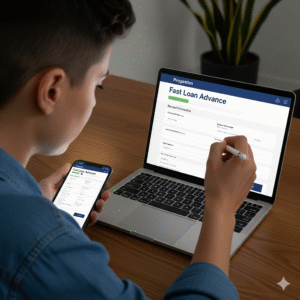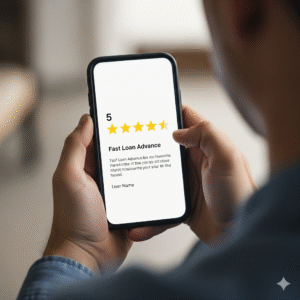Well listen, let’s make one thing clear. Sometimes in life such a situation comes where there is a very urgent need for money. The car suddenly breaks down, there is a medical emergency, or the fridge stops working… at such times Fast Loan Advance or quick cash loans seem like a lifesaver.
And honestly, if there is no other option, then this can definitely be the last resort. But there is a truth that most websites will not tell: these loans are the most dangerous among financial products.
My purpose is not to scare you or sell you anything. I just want to give you the right and clear information. I will review the top platforms, explain their small-print, pros and cons. Most importantly, I will give you a checklist – to see if you really need it, and if you do, how to get it without getting caught in a trap.

An important warning at the start:
Fast loan advances, also known as payday loans, are a short-term fix but their long-term consequences are very bad. Their APR (Annual Percentage Rate) is so high that it sometimes crosses 600%. This can put you into a debt cycle that is very hard to get out of. Please, consider this only when you have no other option left. Your financial health is important.
What is a Fast Loan Advance?
When people look for a “fast loan advance,” they are usually looking for a small, short-term loan that can cover the time until their next paycheck. That’s why they are also called payday loans or cash advances.
The special features of these are:
- Small amount: Generally between $100 and $1,000.
- Short Term: We expect you to repay the full amount plus fees by your next payday (2 to 4 weeks).
- Fast Money: The online application is very simple, and the money is disbursed within 24 hours.
- High Cost: This is the biggest advantage. The fees can be small (e.g. $15 or $30 per $100), but if you annualize it, the APR can be very high.
- No Credit Check: They generally don’t require a good credit score. They just care about your steady income.
They are promoted for emergencies – like car repairs, medical bills, or a utility failure. But “emergency” is the keyword. It’s not about a vacation, new TV, or a night out.

Top Fast Loan Advance Providers Review
Okay, now let’s get into the details. If you’re thinking of taking a loan, you need to know who you’re dealing with. I’ve seen some of the biggest names in this field. Remember, these are not usually direct lenders; they are marketplaces or connecting services. They take your application and forward it to lenders in their network.
1. MoneyMutual
MoneyMutual is probably the most popular name in this field. They have been around for a long time and their lender network is huge.
How it works: You fill out a simple form on their site. They share it with their short-term lender network. If a lender likes your application, they will contact you with an offer. Then you work directly with that lender.
Good (Pros):
- The process is very fast. It takes minutes from application to offer.
- The network is massive, so the chances of finding a lender are high.
- Using the service is free. You only pay when you approve a loan.
Cons:
- Not available everywhere. There are restrictions in many states like New York and Connecticut.
- The interest rates and fees you get from the lender network will be very high. That’s the nature of these loans.
- You will get emails and offers from many lenders.
My opinion: MoneyMutual is a legitimate connector. It’s a fast way to see what offers you are getting. But speed and access come at a cost – that cost is dangerously high rates. Use it just to browse options, don’t assume you’ll get a good deal.

2. CashNetUSA
CashNetUSA is a more direct operation. They are not just a marketplace; in many states they are a direct lender, meaning you are dealing with them from start to finish.
How it works: You apply on their site. They check your credit and make direct lending decisions. If approved, they deposit the money.
Good (Pros):
- They are very transparent about their terms and fees. You will know what you are getting into.
- Sometimes they offer flexible repayment options, such as installment plans, which are slightly better than a single lump-sum payment.
- Funding is very fast, can happen on the same day.
Not good (Cons):
- Their APRs are the highest in the industry. Sometimes they go up to 600%+.
- Their state restrictions are very strict. Loan amount, terms and availability depend on your state.
- Because of being a direct lender, they are a credit
hack which may temporarily reduce your score a little.
My opinion: CashNetUSA is a known quantity. What you see is what you get, and what you get is very expensive money. Their transparency is a plus point, but the cost of borrowing is very high. Consider this only if you have a solid plan on how you will repay on time.
3. Check Into Cash
This is an industry veteran. Check Into Cash has physical stores as well as a strong online presence. This dual approach increases their reach.
How it works: You can apply online or go to the store. Depending on the state, they may act as either a direct lender or a connector.
Good (Pros):
- The option to talk face-to-face with someone in the store can be helpful if you have questions.
- They are known to work with borrowers who have poor or limited credit history.
- The approval process is fast both online and in-store.
Not Good (Cons):
- Loan amounts may be lower than other services.
- Repayment terms are very short and aggressive, typical payday loan model.
- In-store loans can come with higher fees than online loans (since they have to cover overhead).
My opinion: The convenience of a physical location is unique. But a friendly face behind the counter in the store doesn’t make you think that the terms will be friendly too. The same harsh rules apply. Shorter repayment terms are a special red flag because they increase the risk of not being able to repay on time.

Who Qualifies for Fast Loan Advance? (Basic Checklist)
The barriers to entry have been deliberately kept low. Lenders want it to be easy to get a loan, because that’s how they earn money. These are the things you almost always need:
- Legal Age: Must be at least 18 years old.
- Steady Income: This is the biggest thing. You have to prove that you have a regular income coming in, whether it’s from a job, benefits, or pension. They need to know that you can repay them.
- Active Bank Account: This is non-negotiable. They need a checking account for two reasons: to deposit money and, most importantly, to take out repayment on the due date.
- Valid Contact Information: A working email address and phone number so that the lender can contact you.
- Government ID: Driver’s license or state ID so that your identity can be verified.
Guess what’s not on this list? A great credit score. They often use specialized subprime credit checks that don’t affect your mainstream credit score as much, but they do look at your repayment ability.
Real Advantages: Why do people get these loans?
Despite the dangers, people use these services for real reasons. It’s important to acknowledge them.
- Speed is most important: When your utility is disconnected or the car isn’t taking you to the office, banks are very slow. Traditional loans take weeks. Fast loan advances can be approved in minutes and provide cash in hours. This is their primary advantage.
- Accessibility is important: The traditional financial system has closed its doors to people with poor or no credit scores. These advances open a window. The process is simple, online, and doesn’t require a perfect financial history.
- No long-term commitment: You’re not locking yourself into a five-year loan. It’s a quick in-and-out transaction. If used perfectly – borrow once and repay on time – it can do its job without long-term damage.
Massive Disadvantages: That fine print is the one that will hurt you.
This is the part you should read twice.
- Staggering Cost: This is very important. A $15 fee on a two-week loan of $100 is not bad. But let’s do the math: that’s nearly 400% APR. I’ve seen offers with 700%+ APR. You can pay less by spending on a high-interest credit card.
- Debt Trap Cycle: This is the most dangerous part. Suppose you took $300 to get your car fixed. In two weeks, you’d have to pay $345. But what if you can’t pay that $345? Many borrowers take out a second loan to repay the first loan. Then the third. Then the fourth. You’ll find yourself paying hundreds of dollars in fees by rolling over that same $300 debt.
- Aggressive Collection Practices: If you default, the collection process can get aggressive. With access to your bank account, they can try to withdraw funds, which could also lead to overdraft fees from your bank.

How to Choose the Least-Bad Option? (A Responsible Borrower’s Checklist)
If you have no other choice, please use this checklist. Don’t just accept the first offer you see.
- Is it legal here? First, check if the service operates in your state. State laws vary, and some make these loans outright.
- Calculate the true, total cost. Don’t look at the dollar fee. Look at the APR. The law says they have to disclose it. If the APR is more than 100%, run. If it’s more than 300%, seriously reconsider your life choices. Calculate exactly how much money you will have to pay on the due date.
- Read every word of the agreement. I am telling the truth. Scroll through the entire document. Look for hidden fees: origination fees, late payment fees, non-sufficient funds (NSF) fees. Know what you are signing.
- Check their reputation. Go beyond the platform’s own website. Check them on the Better Business Bureau (BBB). Read reviews on Trustpilot and Google. See what real people are saying about repayment and collections.
- Create a rock-solid repayment plan. This is the most important step. Before you click “Accept”, look at your next paycheck. Where will you get that $345 from? What will you sacrifice to repay it? If you don’t have a clear, specific answer, then don’t take the loan at all.
Read more: Quick2Lend Reviews: The Ultimate Guide to Fast Cash Loans ❤️
What are the alternatives?
(Be sure to look here first!)
I encourage you to try these options thoroughly before considering a payday loan.
- Local Credit Unions: They often offer small, short-term loans called Payday Alternative Loans (PALs), with a maximum APR of up to 28%. The amounts are small, but the cost is very low.
- Payment Plans: Talk to the people you owe money to! Hospitals, utility companies, and landlords often let you set up a payment plan. What does it take to ask?
- Side Hustle for Quick Cash: Can you drive Uber/Lyft on the weekend? Can you sell old clothes or electronics on Facebook Marketplace? The money you get from doing a day’s gig is better than borrowing money with strings attached.
- Ask family or friends: This can be awkward, I know. But it’s almost always interest-free and the repayment terms are more flexible. Be honest and write down an agreement to avoid misunderstandings.
- Assistance Programs: Organizations like United Way (dial 211), local community action agencies, and religious organizations have utilities and emergency assistance programs for rent.
Conclusion: So is it worth it?
This is my honest, human opinion.
Fast loan advances are a financial tool, but they’re like using a chainsaw to trim a bonsai tree. It’s overpowered, dangerous, and can do more damage than the original problem.
In a genuine, one-time emergency, where you have absolute certainty that you will repay the full amount by the exact due date, and you’ve exhausted every alternative, it may work.
But for 99% of situations, the risks far outweigh the benefits. The potential for getting caught in a debt cycle that can alter your life is true.
Please protect your future self. Use the alternatives list. Make phone calls. Sell the whole guitar.







